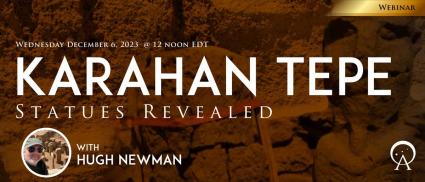
In September 2023, a new enclosure at Karahan Tepe was uncovered, revealing, two remarkable unique statues. Located just 23 miles (37 km) southeast of Göbekli Tepe, Karahan Tepe is part of the Taş Tepeler (Stone Hills) project in Turkey. Karahan Tepe dates back 11,400 years, which makes the find of the human statue the oldest ever found on Earth.
Join Hugh Newman of Megalithomania who was present and reveals these remarkable statues in this webinar for Ancient Origins members. The first Karahan Tepe statue is the world’s earliest example of a realistic human depiction. Measuring 7 feet 6 inches tall (2.3 m), it was found broken in two, the top part recumbent on the floor. The legs appear to have been found in situ and were originally placed on the bench sitting upright.
Comparing the differences between the Balıklıgöl Statue /Urfa Man and Karahan Tepe Man here is a clear difference in the eyes. While the Karahan Tepe statue includes eyes which have clearly been carved, the eyes on the Urfa Man are black obsidian. The Urfa Man appears to be bald, whereas a notable beard and hairstyle are evident on the Karahan Tepe statue. The hairline also raises interesting questions because the Karahan Tepe statue appears to include a shaved area above the ears, much like a form of Mohican, a design found on various statues from Gobekli Tepe. The Karahan Tepe statue stands at a remarkable 7 feet 6 inches in height (2.3 m), while Urfa Man is a mere 5 feet 9 inches tall (1.8 m).
Which raises the question: Is the statue therefore an early depiction of a giant? Could this be the first ever detailed human statue of an original Anunnaki of Sumerian tradition, or a Watcher from the Book of Enoch?
The Karahan Tepe statue, along with Urfa Man, and other statues of men holding their phallus suggest that male fertility was a theme of the Taş Tepeler culture. This may also relate to the Pillar Shrine at Karahan Tepe. The 10 bedrock-carved pillars are notably phallic, and may be an early form of a “shiva lingam” of Vedic tradition.
[[{"type":"media","view_mode":"media_original","fid":"26812","attributes":{"alt":"Hugh Newman","class":"media-image","height":"173","style":"width: 150px; height: 118px; float: left; border-width: 5px; border-style: solid; margin: 5px;","typeof":"foaf:Image","width":"220"}}]]Join Hugh as he discusses the latest findings at Gōbekli Tepe and Karahan Tepe.
Hugh Newman is a special contributor to Ancient Origins, a regular guest on History Channel’s Ancient Aliens and Search for the Lost Giants and organizes the annual Megalithomania conferences and tours.
For more on this compelling research, see Hugh’s newest book, Gōbekli Tepe and Karahan Tepe, the World’s First Megaliths
